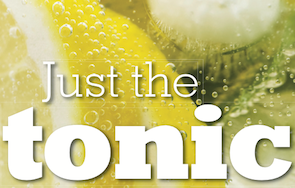She splits flavourings down into three types. “Infused, using the physical fruit [or ingredient]; natural flavourings, which are made of 95% from the named fruit [or ingredient]; and artificial flavours – which are synthesised in a lab.” We won’t match brand to process, but Moore does observe that Schweppes has a different image outside of the UK. “Schweppes is seen as more premium in Europe than in the UK. In Spain it has brought out Pink Peppercorn, Ginger & Cardamom and Orange Blossom & Lavender flavours. Spain is far more developed – it approaches G&Ts with the same curiosity as we do cocktails. I would like to think we could go that way. If we could find tonics that match the effort and creativity that we put into gins it would be great.”
The sister tonic to Gin Mare, 1724 reports a similar tale in its home market. “The restaurant or bar will have thought about which gin goes with which tonic and what garnish to use,” says David Relph, managing director of 10 Degrees C, the brand’s UK agent. “They serve them in enormously large balloon glasses and fill them with good quality ice. Spain has been doing it for three to five years.” And Britvic? “Spain is the clear winner – gin & tonic is the hottest thing in the Spanish market right now,” says Simon Owen, general manager of Britvic International.
“There can be more than 100 varieties of gin on offer and a host of tonics. The Spanish are very serious about the flavours and nuances of G&Ts, in the way that the French might be about their wines or the Scots about their whisky. “We’re seeing this trend creep into other countries, though there’s a long way to go in the UK market, which represents a great opportunity for Britvic and the spirits manufacturers to help shape this behaviour.”
The UK is busy watching its waistline, with more than half of tonic water reportedly in slim-line form. For Fever-Tree and Fentimans this means natural fruit sugars are substituted in – cutting calories by 50% and 30% respectively.
But Fentimans’ Wright is not totally sold. “Slim-line has a different taste profile but people are prepared to compromise,” he says. “[Personally] I don’t understand slim-line tonic – if you are in an indulgent mood, treat yourself...” So far low-calorie tonics are a UK trend. As Wright neatly puts it: “Slim-line doesn’t even register in Europe.”
Alongside the UK and Spain, the US is the third of the triumvirate of gin markets, and therefore tonic markets. Fever-Tree’s Warrillow reports the new investment will allow the brand to expand beyond its 38 markets, and build in the US. “We are seeing rapid expansion in the US with growth of 80% year on year. We were the pioneers of the premium mixer category there – California and Manhattan took to Fever-Tree really early on and now the message is spreading.
Fentimans, a brand that “brews” its botanicals and dresses in Victorian-themed packaging, reports it also has a licensing agreement in place in North America and is seeing growth in gin-friendly markets. “We’ve seen rapid expansion in Scandinavia, Holland, Belgium, Spain, Australia, Japan and Hong Kong,” says Wright.




